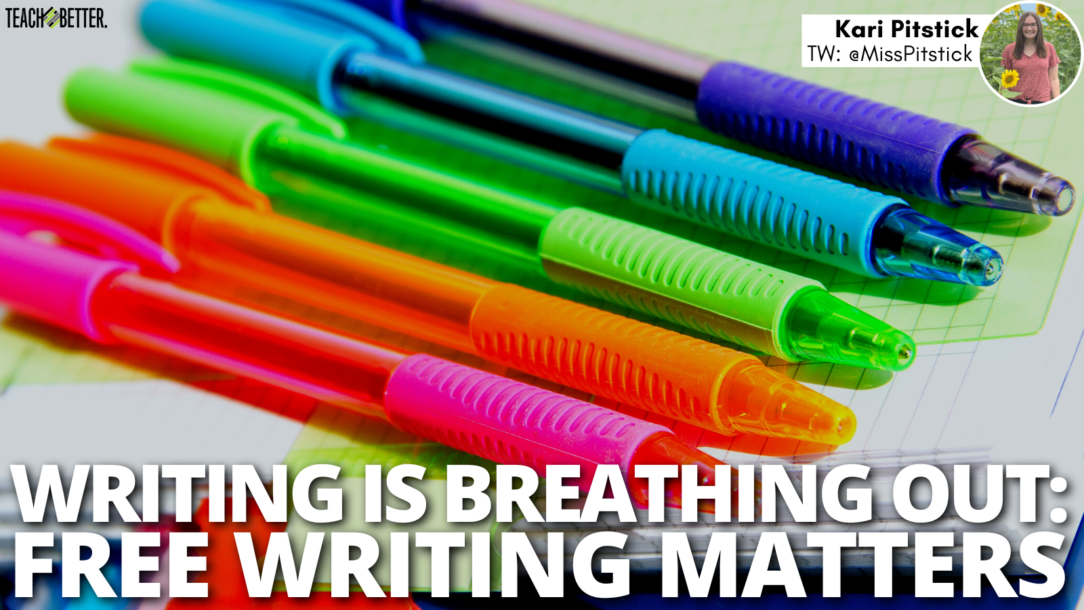TL;DR:
- The post emphasizes the importance of explaining the “why” behind classroom activities, such as free writing, to students.
- Benefits of free writing include boosting creativity, providing a safe space for expression, relieving stress, and improving communication skills.
- The author draws parallels between practicing writing and practicing sports or musical instruments, highlighting the value of preparation for future assignments and real-world communication.
“Reading is breathing in. Writing is breathing out.”
Oftentimes when teachers have students do something, we may forget to share the “why” behind it. Why are we doing this? Why is it important? How will this impact you in the real world today and in the future?
Recently, my class had our first official free writing time of the year. I knew I wanted to first share with students some benefits of free writing along with the expectations I had of them during this time.
I wanted to make good use of my time, so instead of looking at multiple websites to gather reasons why free writing is beneficial, I asked ChatGPT to give me some ideas. Here is what it came up with:
Free writing…
- Boosts creativity
- Is a safe place to express your thoughts/feelings
- Has no rules or judgments; there are no right or wrong answers
- Helps you become a better communicator
- Can help relieve stress and anxiety
- Can help you think through challenges and find solutions
- Allows opportunities for self-reflection
- Gives you time to yourself—a peaceful moment in a busy day
- Trains your mind to concentrate better
I then ask students to raise their hand if they currently or have ever played a sport. I then ask them to raise their hand if they currently or ever have played an instrument. That usually will get everyone’s hand up, but you could add on other things you know of your students to get everyone’s hand up once before moving on (for example, if you have ever played a video game; if you have ever cooked or baked something new).
I remind students that just like playing a sport or instrument, you practice so you’re ready for the next big game or concert, you also practice writing so you’re ready for the next assignment, essay, important email, etc.
Forming and processing any thoughts and putting them onto paper or on the computer during free write time is the practice. Then, when it’s time to write for something else—anything else—students will be that much better equipped to persevere through writing when they get stuck.
[scroll down to keep reading]After we talk about the benefits of free writing, I then share my expectations with students for this time:
- You may choose to handwrite or type.
- You can use the teacher-given prompt or write about something of your own choice
- You can write about anything you want (fiction or nonfiction stories, journal entries, songs, poems, etc.)
- You can write something different each week or carry on a piece from week to week.
- Listening to music is ok during this time, only if it helps you focus.
- Like independent reading time, there shouldn’t be talking during this time (If students want to collaborate on a writing piece together, they can do that. I do, however, use our computer monitoring software to ensure the students are actually writing and not just conversing back and forth in a document.)
I typically give students 15 minutes of free writing time. If I feel students need it, we may start with 8-10 minutes and work our way up to 15 minutes to help build their stamina during this time. I did try that this year, but after the 10 minutes on our first free write day, students asked for 5 more to continue their work, which I thought was pretty cool!
An important note I’d like to make: I write with students during this time. I do believe it can be incredibly valuable to use free reading and writing times to conference with students about their books and writing. But I also think modeling these things for your students is just as important. It was during this time I also wrote this blog post 🙂
You can learn more about my own journey with writing here: https://teachbetter.com/blog/my-journey-through-the-3-phases-of-writing/
About Kari Pitstick
Kari Pitstick is a 7th grade English Language Arts teacher and track & field coach in Illinois. She’s also the Director of Digital Content for the Teach Better Team. She graduated from Illinois State University in 2015 with a bachelor’s in Middle Level Education, and American College of Education in 2018 with a master’s in Curriculum & Instruction.
She knew she wanted to teach at the middle level since she was in middle school herself. One of her main missions is to provide a safe and friendly environment for students to explore their passions as learners and as people.
Kari is an avid reader, spending most of her free time reading and writing, and she hopes to share that passion with all those around her—students and adults, alike!




